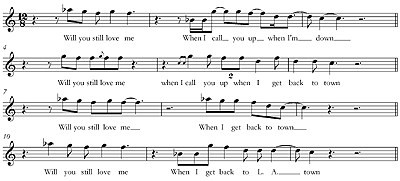Before signing off, the theory nerd in me wishes to share a few observations about the song. "Blue Motel Room" falls into an AABA form (played twice). One interpretation of the harmonies spells some of them as triads with extensions. This style aids readability, but it disguises some of the progression's inner logic. Another way of spelling the chords uses descending parallel triads with altered bass:
| Triad: | C | F | Eb | d | Db | c | F | C |
| Bass: | C | G | F | F | Eb | Eb | G | C |
The chords make more sense as a linear descent than if you tried to attach Roman numerals to them. There is still some tonic-dominant polarity lurking about, though. The bass for the second-to-last chord jumps up to ^5 and has a clear dominant functions. The chord itself is a funny hybrid, a subdominant-as-dominant, but with ^5 in the bass.
Why is the linear descent broken up? What would happen if a d harmony was substituted for the F/G there? I have two thoughts on why she made this decision. First of all, it gives some contrast to the progression. If it was one long linear descent, you'd lose a sense of tonic after a while. The resolution to C at the end would feel like less of an achievement.
The other possibility is that the tonic always seems in danger of slipping to Bb. Bb and Eb appear in enough of the harmonies that it would be very easy to modulate there if you tried. When I was first working out the voice leading for the changes, I made some inadvertent modulations to Bb major. Sticking in the F/G chord makes it clear that, at least for the time being, the song is staying in C. The resolution to the tonic at that point feels like an act of restraint, well-suited to the insecure lyric there: "Will you still love me / When I call you up when I'm down."
The unstable tonic seems to explain why the B section opens with a BbM7 chord. With this move, the lyrics change from personal insecurities to demands and accusations directed at the unnamed lover. She's no longer holding back quite as much. The lyrics in all of the A sections stick to personal reflections on the emotional strain of being away from home and the man in question (a conflation of emotional and physical dislocations is a central theme of the album). The B sections get more specific about the relationship in question (but only slightly — still more restraint): "You and me, we're like America and Russia...", "You lay down your sneaking round the town, honey / And I'll lay down the highway."
One last thing. No fancy analysis, just my amazement at the range of expression you can get by altering the delivery of a line:

3 comments:
Have you heard my CD "JAZZ TAKES ON JONI MITCHELL?"
Lew Tabackin, playing tenor sax, is featured on "Blue Motel Room."
be well, DAVID LAHM
dflahm@aol.com
Adam, your performance was awesome--I was there, standing right behind you in the main hall, having already played twice on the program (Schwendinger and Pentland).
hi ! I'm French ... and I found your comment on Blue Motel Room quite interesting while searching on the web for a music sheet of the song
I sing it in a A key
this song is really nicely blue ...
I love the words as much as the music
Post a Comment